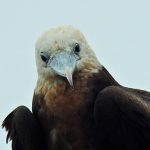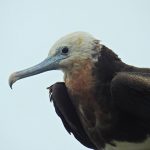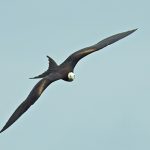The Lesser Frigatebird: A Master of the Australian Skies
Among the vast blue skies and shimmering waters of northern Australia, a unique silhouette often captures the gaze of those who look up: the Lesser Frigatebird. This remarkable seabird, a member of the frigatebird family, is celebrated for its extraordinary aerial prowess and striking appearance. Its story is woven with adaptation, agility, and the quiet drama of survival in one of nature’s most demanding theatres—the open ocean.
Physical Description and Sexual Dimorphism
- Males: Cloaked in glossy black plumage, male Lesser Frigatebirds are unmistakable during the breeding season. Their most distinctive feature is the red gular sac—a pouch beneath the throat that can be inflated dramatically, forming a bright, balloon-like display to attract potential mates.
- Females: Subtler in tone, females have a white breast and lower neck sides, set off by a sharp black band across the chest. Both sexes share the species’ signature—long, slender wings and a deeply forked tail, perfectly engineered for life on the wind.
| Feature | Male | Female |
|---|---|---|
| Plumage | Glossy black | Black with white underparts |
| Gular Sac | Inflated, red | Absent |
| Tail | Deeply forked | Deeply forked |
| Chest Markings | All black | Black band across white |
Aerial Agility and Behaviour
Lesser Frigatebirds are true aerial specialists. Their wings, spanning up to two metres, enable them to soar for weeks without landing. They ride thermals, steering with subtle flicks of their forked tails, often gliding effortlessly above tropical and subtropical waters.
- Feeding Tactics: These birds have earned a reputation as “pirates of the skies.” While they can deftly snatch fish and squid from the ocean’s surface with their slender bills, they are also known as kleptoparasites—harassing other seabirds mid-flight until the distressed victim releases its catch, which the frigatebird then swoops to collect before it hits the water.
- Adaptations: Unlike many seabirds, Lesser Frigatebirds do not have waterproof feathers. This means they cannot rest or dive in the water—if their feathers become saturated, they risk drowning. Instead, their entire existence is bound to the air and the safety of isolated breeding sites.
Life Cycle and Breeding
Lesser Frigatebirds spend most of their lives soaring above the ocean, coming to land only to breed and raise their young.
- Breeding Range: In Australia, they are found off the northern coast, from Western Australia to Queensland, including the Great Barrier Reef, Timor Sea, and Arafura Sea.
- Nesting: They breed on remote islands, building nests in low-lying bushes or trees, away from most land-based predators.
- Longevity & Maturity: These birds can live for up to 30 years. They reach sexual maturity at around 5 to 7 years and usually breed every other year, as raising a chick is a demanding investment of time and energy.
Conservation and Challenges
While the Lesser Frigatebird is currently listed as Least Concern by the IUCN Red List, their populations face several threats:
- Habitat Destruction: Loss or disturbance of breeding islands due to human activity and invasive species.
- Entanglement: Accidental capture in fishing gear can be fatal.
- Disturbance: Human encroachment can disrupt breeding colonies, leading to nest abandonment.
Conservation Message
The survival of the Lesser Frigatebird is a testament to nature’s ingenuity. Their story reminds us of the delicate balance within marine ecosystems. Protecting their breeding islands, minimising ocean pollution, and ensuring sustainable fishing practices are essential steps to secure their future.
Sensory Snapshot: Experiencing the Lesser Frigatebird
Imagine standing on a windswept island at dawn. The air is tinged with the salty tang of the sea. Overhead, the sky is streaked with sleek black forms, wings outstretched, tails forked like the streamers of a kite. Their silhouettes glide silently, only occasionally punctuated by a guttural call or the rush of air as they swoop to intercept another bird. The brush below is dotted with rough, twiggy nests—each holding the promise of new life. The scene is vibrant, dynamic, and tinged with the timeless rhythms of nature.
Conclusion
The story of the Lesser Frigatebird is not just a tale of survival, but a celebration of adaptation, elegance, and the enduring wonders of Australia’s wild places. As we marvel at their effortless flight and unique behaviours, we are reminded of our own role in protecting the natural world. By safeguarding their habitats and reducing human impacts, we ensure that future generations will continue to be inspired by these remarkable birds—masters of the Australian sky.



